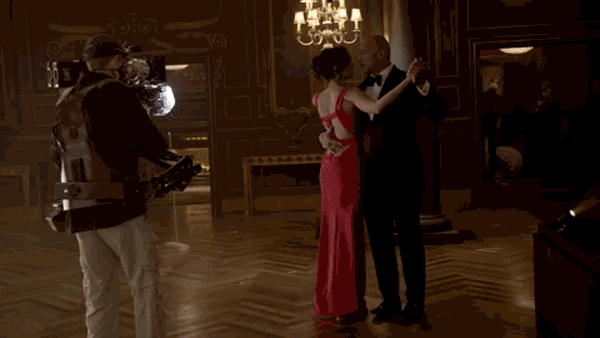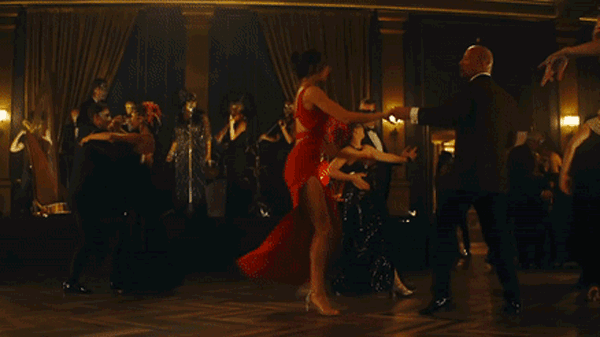Francesco Panzieri is no stranger to large-scale productions, with credits including Once Upon a Time in Hollywood, Star Wars: The Force Awakens, Spiderman: Homecoming, Avengers: Infinity War, Terminator: Dark Fate, Jingle Jangle and Dune. Still, the Covid-19 pandemic presented him with new challenges on the set of Netflix’s Red Notice. The original production plan for Red Notice included flights to Paris, Italy and Sarandino for the movie’s stand-out scenes. However, the Covid-19 outbreak stopped production in its tracks and forced the production team to recalibrate.
Many of the scenes we see in the film with Dwayne “The Rock” Johnson, Ryan Reynolds and Gal Gadot are devoid of extras and stand-ins. The lead actors were often working alone or with each other.
Although it is a testament to the talent of the actors in the film, it is also a testament to the immense talent of Francesco and his team members.
The Netflix In-House Composting Team, led by NYFA 3D Animation & Visual Effects Alum Francesco Panzieri, created a world somewhere in the past, the unforeseen future and entirely outside of the year 2020: a world without facemasks and without travel restrictions.
Francesco Panzieri sat with NYFA and spoke about creating the world(s) of Red Notice and what he hopes audiences take away from the film.
New York Film Academy (NYFA): How were you approached to work on the project for Red Notice?
Francesco Panzieri (FP): I was referred to the visual effects producers on Red Notice and started working as part of the In-House team at the beginning of January 2021. Our In-House roster went from 3 artists (including myself) to 8 by the peak point of post-production (July 2021).
We began working on the post-visualization first, with a certain focus on the ballroom sequence and the waterfall sequence. We worked on temping a little over 150 shots, and once the director’s cut was presented to the studio in March/April 2021, we then started working on the final shots. The In-House team finaled over 340 shots in about 7 months of post-production on the final cut. A truly remarkable amount of work!
NYFA: What was the biggest highlight for you while working on Red Notice?
FP: I had the great privilege of being the lead compositor of a team made of extremely hard working artists who brought their best skills and demeanor to the show. I believe that our collective work truly stands out when watching Red Notice, and it has definitely improved the quality of the final picture. We all had a fantastic time working together, although remotely; that only helped making the workload a bit lighter on our shoulders. I think that the human factor on the show was most likely my favorite aspect.


Dwayne “The Rock” Johnson and Gal Gadot filming Red Notice’s famous dance scene, alone (left). The final, combined scene including the band and dancers who were filmed separate from Gadot and Johnson (right).
NYFA: What was the biggest professional challenge while working on Red Notice?
FP: The biggest challenge in the movie was definitely the scope and the breadth of work. In-House was in charge of the final compositing on the ballroom sequence and the museum sequence. When the pandemic hit the production, Netflix had to stop filming Red Notice. Once things got more under control, the main actors made it clear that in order to reprise the main photography, the set had to be empty of any additional actors/stand-ins/extras for safety reasons. They wanted it to be just them, the director, and a few department heads. Therefore, our extraordinary VFX Supervisor Richard Hoover came up with the technique of shooting Gal, Ryan and Dwayne alone on-set (I’ll call this the A-Camera), and then shooting the background plates with the dancers that would end up in the BG with a B-Camera, all while mimicking the A-Camera movement with the help of visual guides on the floor and walls such as tape and LED markers, and blocking the camera position every one second with the help of a metronome. So every one second, the steadicam operator knew exactly at which position-mark he had to stand in the physical space of the set. Richard would then have an immediate look at the mix to check how close were the B takes to the A takes. After shooting had wrapped, the ball landed into our court.
The In-House team had to manually extract the stand-in actors from the B-Camera plates (a process called rotoscoping), and composite them seamlessly behind Gal, Ryan and Dwayne. Since there was no motion control camera used during the shooting, the B-Camera plates weren’t perfectly aligned to the A-Camera ones, so there was a considerable amount of stabilization and matchmoving done on our side to let everything flow together. In-House also had to deal with a significant amount of edge work and hair integration in order to make each shot feel natural.
This was a gigantic task to be done on-set first, and in compositing after, for which I give so much credit to our supervisor and our team of artists. It was something I never had experienced in my career before, and I am so very proud of how we were able to establish a system in place and do over 90 shots for the ballroom sequence and over 50 shots for the museum sequence.
NYFA: What are you hoping audiences take away visually from Red Notice?
FP: I think Red Notice is set to become a classic family “dramedy” movie. The back-and-forths between Dwayne Johnson and Ryan Reynolds are something that makes me giggle every time I watch their interactions on screen. I am a fan of fast-paced movies that still allow you to keep-up with the quickly-evolving story without losing track of it. Red Notice keeps you on the edge of the seat during some scenes, but it’s also a very enjoyable movie that doesn’t require too much effort to follow.
The stunt-men did an excellent job on set, so there are plenty of scenes with really tense chases and fights that were enhanced by solid digital work. We had some great VFX companies such as Industrial Light & Magic and Framestore working on the movie and I am quite certain that Red Notice will offer audiences a couple of hours of fun!
NYFA: What are some of the differences (if any) in working for a streaming company compared with a traditional release via theatre?
FP: That’s a very good question. You need to look at the cinematic fruition process backwards and start from the theaters. Back in the days, when film was still being used to project movies on the big screen, we actually still had a difference in terms of delivery dates and workflow for visual effects because digital frames had to be sent back to get printed on film. The film back then had to be distributed worldwide for theatrical release in a physical fashion, so it was crucial to deliver the VFX work on time in order for everyone to be able to see the movie across the globe on the release date. Nowadays, everything gets done digitally and sent out to theaters electronically.
Therefore studios can now afford to complete a movie 2 weeks before release date, assuming the Digital Intermediate, sound mixing, and all the other post-production stages are all completed as well. In the end, the differences between theatrical versus non-theatrical/streaming releases keep being less day after day.
Attesting the great success of the Red Notice and the strength of the film’s VFX team, Netflix recently announced that two sequels are in order.
NYFA congratulates Francesco Panzieri for all his hard work on Red Notice and his previous projects!
Please note: NYFA does not represent that these are typical or guaranteed career outcomes. The success of our graduates in any chosen professional pathway depends on multiple factors, and the achievements of NYFA alumni are the result of their hard work, perseverance, talent and circumstances.